Dutch East Indies Campaign, Sumatra
Contributor: C. Peter Chen
ww2dbaseWith its Royal Dutch Shell oil refineries at nearby Pladju, the city of Palembang in southern Sumatra, Dutch East Indies was a major objective early in the Japanese campaign southwards. The Allied defenses there consisted of two air groups located in Pangkalan Benteng airfield, also known as P1, and Prabumulih airfield, or P2. The air forces there consisted of the Royal Air Force No. 225 Bomber Group (with two Royal Australian Air Force squadrons) with 40 Blenheim bombers and 35 Hudson light bombers and No. 226 Fighter Group with two squadrons of Hurricane fighters and a number of Hurricane and Buffalo fighters that carried wound from the earlier Malayan and Singapore campaigns. A few American B-17 Flying Fortress heavy bombers were in Palembang in Jan 1942, but they were withdrawn to Java and Australia before the Japanese invasion. The ground troops were led by the Royal Netherlands East Indies Army Lieutenant Colonel L. N. W. Vogelesang, with 2,000 troops under his command in the Palembang area, organized in one South Sumatra Garrison Battalion and one home guard Landstorm company in reserve; there were other Dutch troops in other areas of southern Sumatra, but they lacked mobility and played no part in the subsequent Japanese invasion. A few Dutch navy officers were also present, with one minelayer (Pro Patria) and two patrol boats (P-38 and P-40) under their command.
ww2dbaseOn 13 Feb 1942, the Japanese invasion fleet approached southern Sumatra. While the Allied aircraft took off to attack the naval vessels, Japanese Army Ki-56 and Ki-21 transport planes delivered about 160-180 paratroopers and their supplies over P1 airfield and 90 troopers near the Pladju refineries, escorted by a large force of Ki-43 fighters. The paratroopers failed to take P1 airfield, and another 60 paratroopers were dropped two hours as reinforcements. Those who landed at Pladju gained control of the entire industrial complex without damaging any equipment, though they were driven out after a Landstorm counterattack; the Dutch troops then began a demolition operation to destroy the oil refineries, setting equipment on fire. By the next morning, unable to hold ground, the Japanese paratroopers advanced to the Musi, Salang, and Telang Rivers, and waited there for the main invasion force to arrive.
ww2dbaseThe main Japanese invasion force for southern Sumatra was under the command of Japanese Navy Vice Admiral Jisaburo Ozawa. The fleet consisted of the heavy cruiser Chokai, light cruiser Sendai, 8 destroyers, and 22 transports, which held the invasion force of Japanese Army 229th Infantry Regiment and one battalion from the 230th Infantry Regiment. A covering force sailed in the distance, which was consisted of the carrier Ryujo, four heavy cruisers, one light cruiser, and three destroyers. The invasion fleet was first engaged by British river boat HMS Li Wo, which engaged the much larger Japanese ships with its lone 100-millimeter gun; Li Wo eventually was damaged beyond repair, and rammed into the nearest Japanese transport before being sunk. Meanwhile, an Allied fleet consisted of Dutch cruisers De Ruyter, Java, and Tromp, British cruisers Exeter and Hobart, and 10 destroyers attempted to intercept the invasion fleet, but the fleet gave up after being attacked by aircraft from Ryujo and nearby ground bases. As the Japanese landing forces sailed up the river leading up to Palembang, British aircraft based in Sumatra attacked, sinking the transport Otawa Maru.
ww2dbaseWhile the invasion started, an episode of massacre took place nearby. On 12 Feb, 330 soldiers, nurses, and civilians commandeered the vessel SS Vyner Brooke and attempted to escape from Singapore. On 14 Feb, the freighter was found by Japanese aircraft off the Bangka Island off southeastern Sumatra, sinking her with three bomb hits. The 90-some survivors of the sinking and the Japanese aircraft strafing made it to Bangka Island's Radji Beach. In the evening of 14 Feb, all but one civilian women left the group for a local village with their children, leaving the men on the beach with the Australian military nurses. Shortly after, Japanese soldiers discovered those on the beach, and massacred the men with bayonets. The nurses were marched into the ocean, and when they reached waist-deep water, they were fired upon with rifles. Nurse Vivian Bullwinkel, British Army Private Pat Kingsley, and several other survivors hid in the nearby jungle for several days; Kingsley later died from his bayonet wound. They were eventually found and placed into a prisoners of war camp. Bullwinkel survived the brutal camp treatment and gave evidence against the Japanese at the 1947 war crimes trial in Tokyo.
ww2dbaseOn 15 Feb, it was decided that southern Sumatra, with its weak defenses, was to be abandoned. All of the aircraft and some of the personnel were sent to Java, where the Dutch East Indies seat of government was located; remaining personnel were transferred to India. The aerial evacuation was completed by the evening of 16 Feb, while the evacuation by sea did not complete until 20 Feb.
ww2dbaseWith southern Sumatra evacuated, the 8,000 Dutch reserve troops and 1,200 para-military policemen in northern Sumatra were practically stranded. Lacking adequate transportation, the Dutch were dispersed in small groups. On 8 Mar, they received word of Dutch commander-in-chief General Hein ter Pooten's surrender in Java on 8 Mar; however, most of them chose to disobey the surrender order.
ww2dbaseOn 28 Feb 1942, a sizeable Japanese force set sail from Singapore for northern Sumatra; the force consisted of 27 transports, three cruisers, ten destroyers, and various other smaller vessels, divided in four groups. On 12 Mar, Operation T was launched with landings at Baloeng Bay on Sabang Island, Cape Pedro near Kotaradja airfield, and Iri. The second landing took place at Tandjoengtiram, where the four battalions landed to secure a beach head for the landing of tanks, air groups, and the divisional headquarters. All landings were nearly unopposed as the Dutch lacked the resources to do so. By 22 Mar, the Japanese had routed many Dutch resistance pockets, while Muslim uprisings, sparked by the Japanese invasion, seriously hampered Dutch efforts. The Muslim rebels were threatening civilian evacuation columns at every opportunity, while providing every piece of intelligence they gathered to the Japanese. Morale soon plummeted, and desertions became more frequent across all resistance groups. On 28 Mar, Major General R. T. Overakker surrendered at Blangkedjeren, finally marking the end of resistance on Sumatra.
ww2dbaseA small number of guerrilla groups continued fighting for the following year, but they were generally ineffective in the face of a resourceful occupation force.
ww2dbaseSources: Armchair Reader World War II, Wikipedia.
Last Major Update: Jan 2008
Dutch East Indies Campaign, Sumatra Interactive Map
Photographs
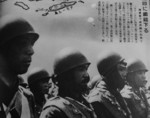 | 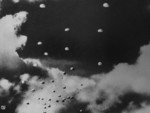 | 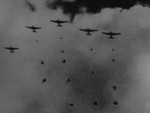 | 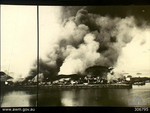 |
Maps
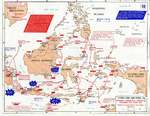 |
Dutch East Indies Campaign, Sumatra Timeline
| 23 Jan 1942 | Japanese bombers attacked Palembang, Sumatra, Dutch East Indies for the first time. |
| 7 Feb 1942 | Japanese aircraft attacked Palembang, Sumatra, Dutch East Indies, destroying 34 RAF aircraft. |
| 11 Feb 1942 | The Japanese invasion fleet for Sumatra, Dutch East Indies departed Cam Ranh Bay, French Indo-China. |
| 14 Feb 1942 | 360 paratroopers of Japanese 1st Airborne Division landed at Pangkalanbenteng airfield near Palembang, Sumatra, Dutch East Indies; in response, ABDA command sent 5 cruisers and 11 destroyers to transport troops to Palembang; Dutch destroyer HNLMS Van Ghent in this force ran aground on Bamidjo reef in the Stolze Strait, forcing USS Stewart to back her engines to avoid colliding into her. Meanwhile, the British ship Vyner Brooke, escaping from Singapore with 300 on board, was bombed off Sumatra; around 100 survivors, including 22 Australian nurses, reach shore on Banka island; the men were marched away by the Japanese and bayoneted and shot, the wounded were bayoneted where they laid, and the nurses were herded into the sea and machine gunned; one, Sister Vivian Bulwinkel, was wounded but survived to tell of the atrocity; she died in 2000, aged 85. |
| 15 Feb 1942 | 100 additional Japanese paratroopers arrived at Palembang, Sumatra, Dutch East Indies, helping with the securing oil refineries and other facilities. 200 kilometers to the south, British troop transport Ocrades arrives at Oosthaven with 3,400 Australian troops, but the ship would continue on to Java without disembarking the troops. North of Palembang, Japanese troops disembarked at the mouth of the Musi River; the British RAF interfered by attacking the landing with over 50 aircraft, sinking 20 landing craft and killing 100 Japanese. Finally, in the Bangka Strait, Japanese naval gunfire sank British tug HMS Yin Ping; 50 were killed, 25 survived. USS Stewart was attacked by aircraft several times, but did not sustain damage. |
| 17 Feb 1942 | Japanese carrier aircraft from Ryujo sank Dutch destroyer HMNS Van Nes, escorting Dutch troopship Sloet van Beele, in the Bangka Strait; 69 were killed, 60 survived. |
| 9 Mar 1942 | Japanese cruisers Kumano, Chokai, and cruiser division 7 depart Singapore to cover Operation T - The Invasion of Northern Sumatra |
| 12 Mar 1942 | On Sumatra, Dutch East Indies, Japanese troops landed at Sabang at 0235 hours, Koetaradja at 0330 hours, Idi at 0540, and Laboehanroekoe at 0700 hours. They would capture the airfield at Medan in the morning. |
| 12 Mar 1942 | Japanese cruisers Kumano, Chokai, and cruiser division 7 cover the landings at Sabang in Operation T - The Invasion of Northern Sumatra |
| 28 Mar 1942 | Dutch Major General Roelof T. Overakker surrendered his 2,000 troops at Blangkedjeren, marking the end of resistance on Sumatra, Dutch East Indies. |
Did you enjoy this article or find this article helpful? If so, please consider supporting us on Patreon. Even $1 per month will go a long way! Thank you. Share this article with your friends: Stay updated with WW2DB: |
Visitor Submitted Comments
18 Jul 2009 07:14:33 PM
The movie 'Paradise Road' with Glenn Close
gives some of the history of the Sumatra Campaign.
5 Oct 2009 09:29:27 PM
http://www.geocities.com/dutcheastindies/fall_sumatra.html has changed to
http://www.dutcheastindies.iblogger.org/fall_sumatra.html
as Yahoo is closing geocities.
20 May 2011 11:28:13 PM
I was in Padang, Westcoast Sumatra, during the War. Any reference or report on the war in that area at that time? E.g., on the seaborne air attack by Allied planes on that city in 1944-1945?
27 May 2011 03:25:20 PM
There is also http://www.dutcheastindies.iblogger.org/north_sumatra.html
22 Oct 2014 01:16:51 PM
looking for information on the Japanese capture of Pandang, Sumatra and near by air field in WWII.
17 Nov 2014 08:17:24 AM
Where can I find a list of the troops that served under General Overakker, and where they fought.
Secondly, for those that were part of the KNIL, were there metals handed out for service and internment?
26 Jan 2025 06:35:47 AM
Where can I find a list of the troops that served under General Overakker, and where they fought.
My father fought there, was captured and ended up on the Burma railroad. He survived, just, but never talked about that period and died when I was still a young teenager.
All visitor submitted comments are opinions of those making the submissions and do not reflect views of WW2DB.
» Ozawa, Jisaburo
Location:
» Dutch East Indies
Ship Participants:
» Chokai
» Hobart
» Kumano
» Mikuma
» Mogami
» Ryujo
» Sendai
» Stewart
» Suzuya
 |
- » 1,150 biographies
- » 337 events
- » 44,024 timeline entries
- » 1,242 ships
- » 350 aircraft models
- » 207 vehicle models
- » 375 weapon models
- » 123 historical documents
- » 260 facilities
- » 470 book reviews
- » 28,627 photos
- » 431 maps
Fleet Admiral Chester W. Nimitz, 16 Mar 1945
Please consider supporting us on Patreon. Even $1 a month will go a long way. Thank you!
Or, please support us by purchasing some WW2DB merchandise at TeeSpring, Thank you!
5 Jan 2008 04:22:04 AM
For another Link about this event see
The Japanese Invasion of Sumatra Island
http://www.geocities.com/dutcheastindies/fall_sumatra.html